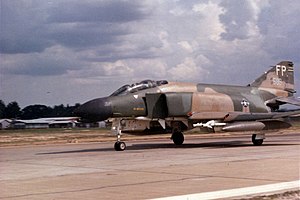
Back Аперацыя «Бола» Byelorussian Operace Bolo Czech Operaatio Bolo Finnish Opération Bolo French Операция «Боло» Russian Chiến dịch Bolo Vietnamese
| Operation Bolo | |||||||
|---|---|---|---|---|---|---|---|
| Part of Vietnam War | |||||||
 8th TFW F-4C Phantom II, circa in 1967 | |||||||
| |||||||
| Belligerents | |||||||
|
|
| ||||||
| Commanders and leaders | |||||||
|
Robin Olds Daniel James, Jr. | Tran Manh | ||||||
| Strength | |||||||
|
56 F-4C Phantom IIs (28 participated) |
16 MiG-21 'Fishbeds' (8 or 9 engaged) | ||||||
| Casualties and losses | |||||||
| None |
US claim: 5 MiG-21PFL lost (c/n 1812, 1908, 1909, 2106, 2206) | ||||||
Operation Bolo was a United States Air Force mission during the Vietnam War, considered to be a successful combat ruse.[1]
The mission was a response to the heavy losses sustained during the Operation Rolling Thunder aerial-bombardment campaign of 1966, during which Vietnam People's Air Force fighter jets had evaded U.S. escort fighters and attacked U.S. bombers flying predictable routes. On January 2, 1967, U.S. Air Force F-4 Phantom II multirole fighters flew a mission along flight paths typically used by the bombers during Rolling Thunder. The ruse drew an attack by Vietnamese Mikoyan-Gurevich MiG-21 interceptors, whose pilots expected to find heavily loaded fighter-bombers. Instead, they were met by the far more agile F-4s, which shot down seven of the MiGs.
The battle prompted VPAF pilots and strategists, as well as Soviet tacticians, to re-evaluate the tactics and deployment of the MiG-21.
- ^ Futrell, R. Frank; Greenhalgh, William H.; Grubb, Carl; Hasselwander, Gerard E.; Jakob, Robert F.; Ravenstein, Charles A. (January 1976). Eastman, James N.; Hanak, Walter; Paszek, Lawrence J. (eds.). United States Air Force in Southeast Asia 1965-1973. Aces and Aerial Victories. Washington, D.C: Office of Air Force History. OCLC 18844042 – via Defense Technical Information Center. https://apps.dtic.mil/sti/citations/tr/ADA476450.
© MMXXIII Rich X Search. We shall prevail. All rights reserved. Rich X Search